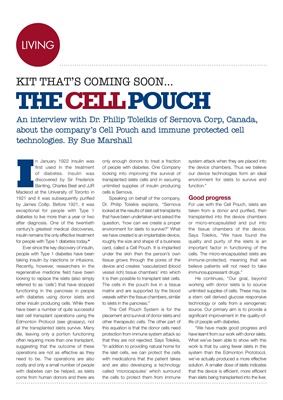
LIVINGLIVING
KIT THAT'S COMING SOON...
THE CELL POUCH
In January 1922 insulin was
first used in the treatment
of diabetes. Insulin was
discovered by Sir Frederick
Banting, Charles Best and JJR
Macleod at the University of Toronto in
1921 and it was subsequently purified
by James Collip. Before 1921, it was
exceptional for people with Type 1
diabetes to live more than a year or two
after diagnosis. One of the twentieth
century's greatest medical discoveries,
insulin remains the only effective treatment
for people with Type 1 diabetes today.*
Ever since the key discovery of insulin,
people with Type 1 diabetes have been
taking insulin by injections or infusions.
Recently, however, researchers in the
regenerative medicine field have been
looking to replace the islets (also simply
referred to as 'cells') that have stopped
functioning in the pancreas in people
with diabetes using donor islets and
other insulin producing cells. While there
have been a number of quite successful
islet cell transplant operations using the
Edmonton Protocol (see glossary), not
all the transplanted islets survive. Many
die, leaving only a portion functioning
often requiring more than one transplant,
suggesting that the outcome of these
operations are not as effective as they
need to be. The operations are also
costly and only a small number of people
with diabetes can be helped, as islets
come from human donors and there are
An interview with Dr. Philip Toleikis of Sernova Corp, Canada,
about the company's Cell Pouch and immune protected cell
technologies. By Sue Marshall
only enough donors to treat a fraction
of people with diabetes. One Company
looking into improving the survival of
transplanted islets cells and in securing
unlimited supplies of insulin producing
cells is Sernova.
Speaking on behalf of the company,
Dr. Philip Toleikis explains, "Sernova
looked at the results of islet cell transplants
that have been undertaken and asked the
question, 'how can we create a proper
environment for islets to survive?" What
we have created is an implantable device,
roughly the size and shape of a business
card, called a Cell Pouch. It is implanted
under the skin then the person's own
tissue grows through the pores of the
device and creates 'vascularized (blood
vessel rich) tissue chambers' into which
it is then possible to transplant islet cells.
The cells in the pouch live in a tissue
matrix and are supported by the blood
vessels within the tissue chambers, similar
to islets in the pancreas."
The Cell Pouch System is for the
placement and survival of donor islets and
other therapeutic cells. The other part of
this equation is that the donor cells need
protection from immune system attack so
that they are not rejected. Says Toleikis,
"In addition to providing natural home for
the islet cells, we can protect the cells
with medications that the patient takes
and are also developing a technology
called 'microcapsules' which surround
the cells to protect them from immune
system attack when they are placed into
the device chambers. Thus we believe
our device technologies form an ideal
environment for islets to survive and
function."
Good progress
For use with the Cell Pouch, islets are
taken from a donor and purified, then
transplanted into the device chambers
or micro-encapsulated and put into the
tissue chambers of the device. Says
Toleikis, "We have found the quality
and purity of the islets is an important
factor in functioning of the cells. The
micro-encapsulated islets are immuneprotected,
meaning that we believe
patients will not not need to take
immunosuppressant drugs."
He continues, "Our goal, beyond
working with donor islets is to source
unlimited supplies of cells. These may be
a stem cell derived glucose responsive
technology or cells from a xenogeneic
source. Our primary aim is to provide a
significant improvement in the quality-oflife of people with diabetes.
"We have made good progress and
have learnt from our work with donor islets.
What we've been able to show with this
work is that by using fewer islets in this
system than the Edmonton Prototocol,
we've actually produced a more effective
solution. A smaller dose of islets indicates
that the device is efficient, more efficient
than islets being transplanted into the liver,